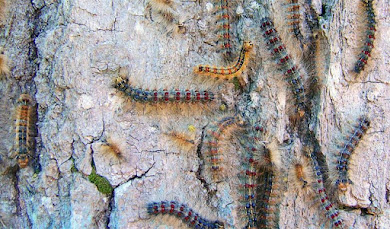“Suppression efforts will begin in early May as these insects emerge and begin feeding,” Dunn said. “Our cool, wet springs had helped limit the impact of the spongy moth in recent years past, but the pests’ populations again climbed in many areas in 2021 and 2022 to a point where aerial spraying is needed to keep this invasive pest in check and protect the trees from defoliation.”
In 2021, spongy moth defoliated 326,124 acres in Pennsylvania.
DCNR’s Bureau of Forestry will oversee the spraying of 220 sites totaling 209,838 acres. Included will be portions of 13 state forests, 10 state parks, and sections of the Allegheny National Forest in 20 counties located in southcentral, central, northcentral, northwest, and northeast Pennsylvania.
In 2021, a total of 203,569 acres were treated. In addition to DCNR’s spray program, the Game Commission will also be conducting an aerial spray program in 2022 on approximately 63,000 acres of State Game Lands.
State parks to be sprayed include Pine Grove Furnace, Cumberland County; RB Winter, Union County; Chapman, Warren County; Sand Bridge, Union County; Parker Dam, Clearfield County; Elliot, Clearfield County; Sizerville, Potter County; Ravensburg, Clinton County; Little Pine, Lycoming County; and Prince Gallitzin, Cambria County.
“In Pennsylvania, these destructive, invasive insects go through cycles where outbreaks generally occur every five to 10 years,” said DCNR Forest Health Manager Dr. Donald A. Eggen. “Populations had declined in 2019 and 2020 thanks to the spongy moth fungus disease and wet spring weather, but that no longer is the case in 2022.”
The suppression program is conducted with the goal of minimizing defoliation so that trees do not become stressed and succumb to disease, other insect pests, or drought.
Aerial spraying will be conducted by one helicopter and five fixed-wing aircraft.
Progress of the spray program can be followed using the interactive map on the DCNR webpage, which shows the location of all 220 spray blocks:
Targeted sites are determined by surveys of egg masses and other indicators across the state indicating populations are increasing and have the potential to cause major defoliation.
Feeding while in the larval – or caterpillar – stage, the insect usually hatches and begins feeding from mid- to late April in southern Pennsylvania, and in early to mid-May in the northern part of the state.
Oak, apple, sweet gum, basswood, birch, aspen, and willow trees are most affected by the spongy moth.
Bureau of Forestry experts note the state’s oak stands are especially vulnerable to infestations, often resulting in tree mortality.
The loss of habitat, timber, and tree growth are considerable when populations go untreated. A tree begins to significantly suffer when 30 percent or more of its leaf surface is lost.
The applied insecticides, tebufenozide or Bacillus thuringiensis subsp. kurstaki, must be ingested by young caterpillars as they feed on emerging foliage.
Begun in 1972, the forest insect spray program is a cooperative effort among DCNR and the USDA Forest Service's Forest Health Protection Unit.
The Lymantria dispar was introduced to North America in 1869 at Medford, Mass., where it was used in a failed silk-production experiment. The spongy moth first reached Pennsylvania in Luzerne County in 1932, and since then has infested every county.
Visit DCNR’s Spongy Moth webpage for more information.
For more information on state parks and forests and recreation in Pennsylvania, visit DCNR’s website, Visit the Good Natured DCNR Blog, Click Here for upcoming events, Click Here to hook up with DCNR on other social media-- Facebook, Twitter, YouTube and Flickr.
Related Article:
-- DCNR Blog: Restoring A Forest Devastated By Lymantria dispar (Gypsy Moth)
[Posted: April 29, 2022] PA Environment Digest


No comments :
Post a Comment